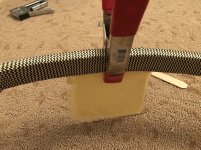Like Muddyfeet mentioned, I ran into a similar issue with some of my boards warping in or out after applying the first coat of drywall mud. It happened in just a few spots between stations where it was already kinda floppy. I really had to lay extra layers on thick in those spots. I’m liking Alan’s method, and will try that if I build another one. In any case, I just have to sand a few small touch up spots and I’m calling the plug good enough!
Also, the materials have arrived! I feel like a kid at Christmas

Here’s the layup schedule for now, inside to out, more on that later. As you’ll notice, I’m going
pretty light on this solo. I won’t have to worry about “dry footed, rapid shooting, dang I’m tired let me huck this canoe off my back” trip mates if I’m the only one in it.
- 0.8 oz surfacing veil chop strand mat - 50 in
- 9.2 oz plain weave Kevlar - 60 in (left over from 2 builds ago)
- 4 oz E-glass - 50 in
- 4 oz S-glass football - 30 in
Stems: 5 oz Kevlar, a layer inside and out
Foam core: 1/4” divinicell H80 grid type, covered with 1 layer of 6 oz intermediate modulus carbon fiber. Maybe I’ll add a layer of the tightly woven 3.16 oz E-glass I have left over. Maybe.
Gunwales: Same Divinicell foam covered in this cool carbon-Kevlar snakeskin thing. The sleeve is 7.5 oz
Epoxy; RAKA 127 thin, 350 non-blush hardener.
Peel ply will be used everywhere.
What I’m still debating:
- Surfacing veil. I bought this because I’m worried the foam core won’t bond very well to the bare Kevlar. It works best with vinylester, but this video inspired some confidence that it could work. Currently testing a sample in my garage. I really don’t like using a plastic spreader or a foam brush on it. Will try a foam roller next time.
https://youtu.be/uLKiDa2dqq8
- Gunwales: Is 1/4” divinicell on either side of the hull too thin? I have enough to do 2 layers (1/2”) on the outside, 1 layer (1/4”) on the inside. Pictured is that setup.










